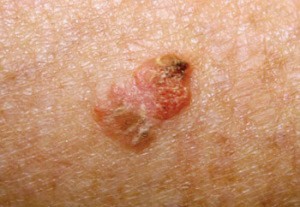Riverchase Dermatology and Cosmetic Surgery –


What do AK’s look like?
AK’s are usually small red slightly raised bumps with attached dry scaly skin or scab. The scab or crust is usually tightly adherent or concave like a cornflake, such that attempting to remove it yourself might cause pain or bleeding. Some patients report abnormal skin sensations such as pain, itching, burning, or tingling. Some patients only complain about the abnormal feel or texture of their skin such as granular, gritty, or nutmeg-grater-like. AK’s are usually multiple, and sometimes they can be felt more easily than seen.
What is the cause of AK’s?
Based on their typical locations, the most obvious cause of AK’s is chronic excessive sunlight exposure accumulated over a period of years. Less common causes of AK’s are X-rays (radiation) and industrial chemicals such as arsenic.
What is the risk of AK’s?
AK is the first step in the development of squamous cell carcinoma, a type of skin cancer that has the biologic potential to spread. However, the majority of AK’s do not progress to skin cancer. Although it has been estimated that up to 10% of AK’s transform into squamous cell carcinoma, it is virtually impossible to predict which ones will progress, regress, or stay the same. Therefore, it is the dermatologist’s goal to treat all or as many AK’s as possible to prevent cancer.
How are AK’s treated?
We are fortunate that there are many effective treatments for AK’s. For patients who have several scattered well-defined AK’s, liquid nitrogen cryosurgical destruction is usually the treatment of choice. This method is quick, bloodless, and effective. The top layer of skin cells where the precancerous cells reside is killed by the extremely cold temperature of the liquid nitrogen. The only side effects are a temporary burning sensation and some decreased pigmentation of the skin. Healing takes place in about 1-2 weeks, and the local care is straightforward.
There are three different topical creams that have been approved and are marketed for the treatment of AK’s. Each one works well by a different mechanism of action. These medicines are more likely to be prescribed when a patient has too many lesions to count, or an entire area or segment of the body shows obvious severe sun damage (such as face, bald scalp, upper chest, backs of arms or hands), if the AK’s are not easy to delineate from normal skin, or if the patient simply cannot tolerate the discomfort of cryosurgery or declines to receive liquid nitrogen.
Actinic Keratoses: Prognosis and Prevention
The prognosis for treated actinic keratoses (AK’s) is excellent. However, the patients who have many AK’s have accumulated so much sun damage in their lifetimes that it is very likely they will eventually develop new or recurrent AK’s. Especially if they do not change some habits. The treatments described in the previous blogs may have to be repeated several times and may even fail in some patients. A failure to respond may indicate that the precancerous AK has already progressed into a squamous cell cancer.
Moreover, some patients may develop other skin cancer types such as basal cell carcinoma and melanoma directly from sun-damaged skin without first beginning as AK’s. A skin biopsy will help to answer the question and determine the next step in treatment.
Can AK’s and skin cancer be prevented?
It is really never too late to begin practicing sun-safety habits.
1. Seek the shade, especially between 10am and 4pm.
2. Try not to burn.
3. Use a sunscreen with SPF #30 or higher daily.
4. Apply the sunscreen 30 minutes before going out and reapply after swimming or perspiring heavily.
5. Avoid ultraviolet tanning salons.
6. Cover up with clothing, broad-brimmed hat, and ultraviolet blocking glasses (protects the eyes too).
7. Check your own skin head to toe every month in the mirror.
8. Get a professional skin exam every year.
Downtown Naples
261 9th Street
North Naples
1015 Crosspointe Dr.
Marco Island
950 N. Collier Blvd., #303
Fort Myers
7331 Gladiolus Dr.
Cape Coral
413 Del Prado Blvd. S., Suite 101
North Port
14840 Tamiami Trail
1-800-591-DERM(3376)
www.RiverchaseDermatology.com
 Southwest Florida's Health and Wellness Magazine Health and Wellness Articles
Southwest Florida's Health and Wellness Magazine Health and Wellness Articles

